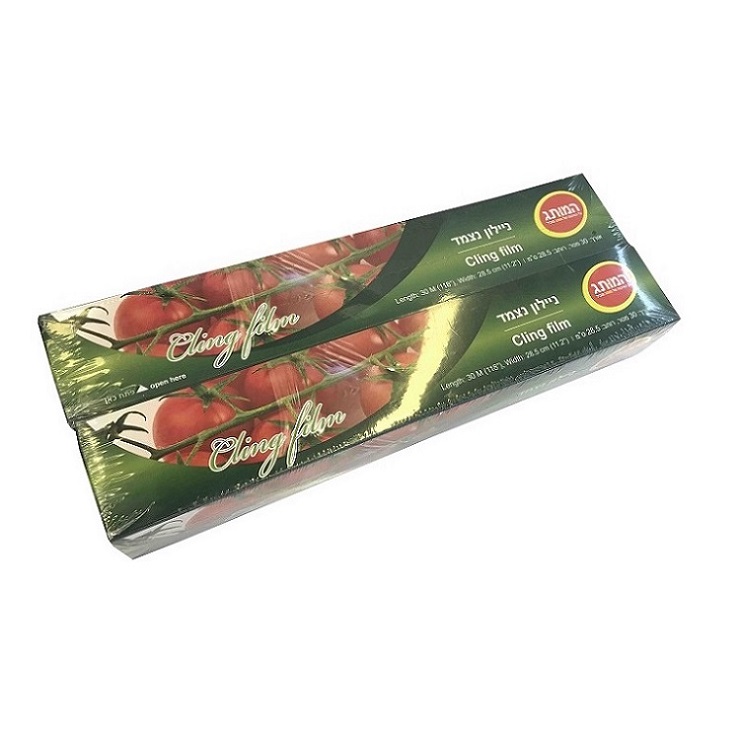We are committed to food packaging PVC cling film, PE cling film,stretch wrap, aluminum foil and other disposal food packing film/foil.

Language
>When it comes to preserving freshness, preventing contamination, and extending the shelf life of fruits and vegetables, cling film has become an essential product in both households and the food industry. Whether you are shopping in a supermarket, storing food in the refrigerator, or preparing meals for a restaurant, you will often see vegetables and fruits wrapped in cling film. Among the many types available, the two most common are PE Vegetable Cling Film and PVC Cling Film.
At first glance, both look similar and serve the same function—protecting food from air, moisture, and odors. However, when we take a closer look at their materials, safety standards, environmental impact, and performance, the differences become clear. Understanding these differences will help you choose the right cling film for your kitchen or business.

What Is PE Vegetable Cling Film?
PE Vegetable Cling Film is made from polyethylene, a widely used plastic known for its safety, flexibility, and recyclability. It is considered one of the most reliable food-grade materials. Unlike some other films, PE Cling Film is free from harmful additives and plasticizers, making it suitable for direct contact with almost all types of food, including vegetables, fruits, meat, dairy, and baked goods.
In addition, PE Cling Film is odorless, transparent, and resistant to punctures, which means it keeps food looking fresh while providing a protective barrier. Its slightly lower stretchability compared to PVC does not affect its ability to cover containers or wrap produce securely. Many supermarkets, catering businesses, and households prefer PE Vegetable Cling Film because it is both safe and eco-friendly, aligning with growing consumer demand for sustainable packaging.
What Is PVC Cling Film?
PVC Cling Film, made from polyvinyl chloride, has been a popular food packaging material for decades. It is highly valued for its superior stretchability, cling strength, and transparency, which allow it to tightly seal around containers and produce. This ensures that food remains fresh for longer and reduces waste.
However, PVC cling film often contains plasticizers and additives that improve its flexibility and performance. While these additives help the film perform well, they have also raised safety concerns in some regions, especially when PVC cling film comes into direct contact with fatty or oily foods. Regulations vary by country, with some markets imposing restrictions on its usage. Despite this, PVC cling film is still widely used in supermarkets and restaurants because of its excellent wrapping ability and cost-effectiveness.
Key Differences Between PE and PVC Cling Film
1. Food Safety
PE Cling Film: Completely free from plasticizers and harmful chemicals. Safe for direct contact with vegetables, fruits, meat, and even fatty foods.
PVC Cling Film: Contains additives. Safe for many uses but may not be suitable for certain foods, depending on local regulations.
2. Clarity and Flexibility
PE Cling Film: Offers high transparency and elasticity, making it easy to use at home or in small businesses. It is slightly less stretchable compared to PVC but still provides a secure wrap.
PVC Cling Film: Extremely stretchable and clingy. It wraps tightly around irregularly shaped items and provides excellent coverage for bulk packaging.
3. Eco-Friendliness
PE Cling Film: Fully recyclable and considered more environmentally friendly. It is aligned with global efforts to reduce plastic waste and promote sustainable packaging.
PVC Cling Film: Recycling is more complicated because of the additives used. This makes PVC less sustainable in comparison.
4. Applications
PE Cling Film: Recommended for wrapping fresh vegetables, fruits, bakery products, and cooked meals in households, supermarkets, and restaurants. It is ideal when food safety and eco-friendliness are priorities.
PVC Cling Film: Still common in large retail and catering businesses where high cling strength and flexibility are essential. It is especially popular for bulk packaging.
Which One Should You Choose?
The choice between PE Vegetable Cling Film and PVC Cling Film depends on your specific needs.
If you are concerned about food safety, environmental impact, and versatility, PE cling film is the better option. It is safe for all food types, recyclable, and increasingly preferred by households and businesses aiming for greener solutions.
If your main priority is maximum stretchability, cling performance, and cost efficiency, PVC cling film may still be suitable, especially for commercial use. However, it is important to ensure compliance with local food safety regulations before choosing PVC.
Conclusion
Both PE Vegetable Cling Film and PVC Cling Film play important roles in food packaging. PE cling film stands out for its safety, eco-friendliness, and wide application range, making it the preferred choice for households and environmentally conscious businesses. On the other hand, PVC cling film continues to be popular in large-scale retail and catering due to its cling strength and flexibility.
As consumer awareness of food safety and sustainability grows, the shift toward PE cling film for vegetables is expected to accelerate. Ultimately, your choice should be based on your packaging needs, food safety standards, and environmental considerations.